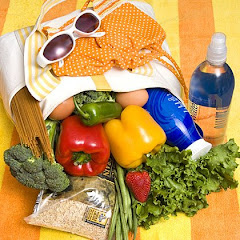10 Tips To Healthy Eating And Physical Activity
1. Start Your Day With Breakfast
Breakfast fills your "empty tank" to get you going after a long night without food. Eating a good breakfast can help you do better in school. Easy to prepare breakfasts include: cold cereal with fruit and low-fat milk, whole-wheat toast with peanut butter, yogurt with fruit, whole-grain waffles or even last night's pizza.
2. Get Moving
It's easy to fit physical activities into your daily routine. Walk, bike or jog to see your friends. Take a 10 minute activity break every hour while you read, do homework or watch TV. Climb stairs instead of taking an escalator or elevator. Try to do these things for a total of 30 minutes every day.
3. Snack Smart
Snacks are a great way to refuel. Choose snacks from different food groups - a glass of low-fat milk and a few graham crackers, an apple or celery sticks with peanut butter and raisins, or some dry cereal. If you eat smart at other meals, cookies, chips, and candy are okay for occasional snacking.
4. Work up a sweat
Vigorous work-outs, when you're breathing hard and sweating, help your heart pump better, give you more energy and help you look and feel your best. Start with a warm-up that stretches your muscles. Include 20 minutes of aerobic activity, such as running, jogging or dancing. Follow-up with activities that help make you stronger such as push-ups or lifting weights. Then cool-down with more stretching and deep breathing.
5. Balance your food choices - don't eat too much of one thing
You don't have to give up foods like hamburgers, french fries, and ice cream to eat healthfully. You just have to be smart about how often and how much of them you eat. Your body needs nutrients like protein, carbohydrates, fat, and many different vitamins and minerals such as vitamins C and A, iron, and calcium from a variety of foods.
6. Get fit with friends or family
Being active is much more fun with friends or family. Encourage others to join you and plan one special physical activity event, like a bike ride or hiking, with a group each week.
7. Eat more grains, fruits, and vegetables
These foods give you carbohydrates for energy, plus vitamins, minerals, and fibre. Besides, they taste good! Try breads such as whole-wheat, bagels, and pita. Spaghetti and oatmeal are also in the grain group.
8. Join in physical activities at school
Whether you take a physical education class or do other physical activities at school, such as intramural sports, structured activities are a sure way to feel good, look good and stay physically fit.
9. Foods aren't good or bad
A healthy eating style is like a puzzle with many parts. Each part, or food, is different. Some foods may have more fat, sugar or salt, while others may have more vitamins or fibre. There is a place for all these foods. What makes a diet good or bad is how foods fit together. Balancing your choices is important. Fit in a higher-fat food, like pepperoni pizza, at dinner by choosing lower-fat foods at other meals. And don't forget about moderation. If two pieces of pizza fill you up, don't eat a third.
10. Make healthy eating and physical activities fun!
Take advantage of physical activities you and your friends enjoy doing together and eat the foods you like. Be adventurous - try new sports, games, and other activities as well as new foods. You'll grow stronger, play longer, and look and feel better! Set realistic goals - don't try changing too much at once.






